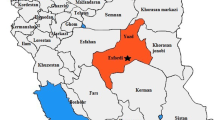Abstract
Rare earth elements (REEs) have found many applications in various industries and technologies. Therefore, their separation from secondary resources, in addition to primary ones, has become significant. Apatite mineral is a necessary ingredient for the wet process, a chemical reaction between apatite and sulfuric acid that culminates production of phosphoric acid. In addition, a by-product called phosphogypsum (PG) is obtained, which is an important secondary source for REEs. In this research with the focus on cerium, lanthanum, neodymium and yttrium, the wet process and the factors affecting it such as temperature and solid to liquid ratio (S/L) were investigated. It was found that temperature has no significant effect on the recovery of REEs and increasing S/L ratio increases REE deposition in PG. Then, the optimum conditions for depositing maximum amount of REEs in PG were determined. After that, a large amount of PG was generated under optimum conditions and its properties were investigated. Then, the PG leaching process was performed by nitric acid solution. The effects of temperature, S/L ratio and acid concentration were evaluated. It was found that the leaching efficiency increases with increasing temperature, decreasing S/L ratio and increasing nitric acid concentration. Finally, the optimum conditions of the aforementioned step were determined for the maximum separation of REEs.








Similar content being viewed by others
References
Jorjani E, Bagherieh A H, Mesroghli S, and Chelgani S C, J Univ Sci Technol Beijing Miner Metall Mater 15 (2008) 367.
Alemrajabi M, Rasmuson Å C, Korkmaz K, and Forsberg K, J Clean Prod 198 (2018) 551.
El-Dessouky S I, El-Sofany E A, and Daoud J A, J Hazard Mater 143 (2007) 17.
Xie F, Zhang T A, Dreisinger D, and Doyle F, Miner Eng 56 (2014) 10.
Xiong C H, Wang G T, and Yao C P, Trans Nonferr Met Soc China 21 (2011) 2764.
Soukeur A, Szymczyk A, Berbar Y, and Amara M, Sep Purif Technol 256 (2021) 117857.
Radhika S, Nagaphani K B, Lakshmi K M, and Ramachandra R B, Hydrometallurgy 110 (2011) 50.
Orabi A, El-Sheikh E, Hassanin M, El-Kady M, and Mowafy A, Miner Eng 122 (2018) 113.
Ferdowsi A, and Yoozbashizadeh H, Trans Nonferr Met Soc China 27 (2017) 420.
Jin H X, Wu F Z, Mao X H, Wang M L, and Xie H Y, Rare Met 36 (2017) 840.
Koopman C, and Witkamp G J, Hydrometallurgy 58 (2000) 51.
Koopman C, and Witkamp G J, Hydrometallurgy 63 (2002) 137.
Masmoudi-Soussi A, Hammas-Nasri I, Horchani-Naifer K, and Ferid M, Hydrometallurgy 191 (2020) 105253.
Canovas C R, Chapron S, Arrachart G, and Pellet-Rostaing S, J Clean Prod 219 (2019) 225.
Wang L, Long Z, Huang X, Yu Y, and Zhang G, Hydrometallurgy 101 (2010) 41.
Preston J S, Cole P M, Du Preez A C, Fox M H, and Fleming A M, Hydrometallurgy 41 (1996) 21.
Grabas K, Pawelczyk A, Strek W, Szeleg E, and Strek S, Waste Biomass Valoriz 10 (2019) 3143.
Walawalkar M, Nichol C K, and Azimi G, Hydrometallurgy 166 (2016) 195.
Al-Thyabat S, and Zhang P, Hydrometallurgy 153 (2015) 30.
Hammache Z, Bensaadi S, Berbar Y, Audebrand N, and Amara M, Sep Purif Technol 254 (2021) 117641.
Acknowledgements
This research was carried out in the framework of the Iran’s National Elites Foundation at Sharif University of Technology. The authors are grateful to Vice-Chancellor of Research of Sharif University of Technology for financial support. Mr. Ali Shoughi, Mrs. A. Familifard and Mr. M. Maarefvand are thanked for their technical supports and useful assistance.
Author information
Authors and Affiliations
Corresponding author
Additional information
Publisher's Note
Springer Nature remains neutral with regard to jurisdictional claims in published maps and institutional affiliations.
Rights and permissions
Springer Nature or its licensor (e.g. a society or other partner) holds exclusive rights to this article under a publishing agreement with the author(s) or other rightsholder(s); author self-archiving of the accepted manuscript version of this article is solely governed by the terms of such publishing agreement and applicable law.
About this article
Cite this article
Golahdooz, M.R., Lashgari, V.A. & Yoozbashizadeh, H. Separation of Rare Earth Elements from Phosphogypsum Obtained from the Processing of Apatite Concentrate from the Chadormalu Mine by Acid Leaching. Trans Indian Inst Met 76, 1885–1891 (2023). https://doi.org/10.1007/s12666-023-02899-0
Received:
Accepted:
Published:
Issue Date:
DOI: https://doi.org/10.1007/s12666-023-02899-0




